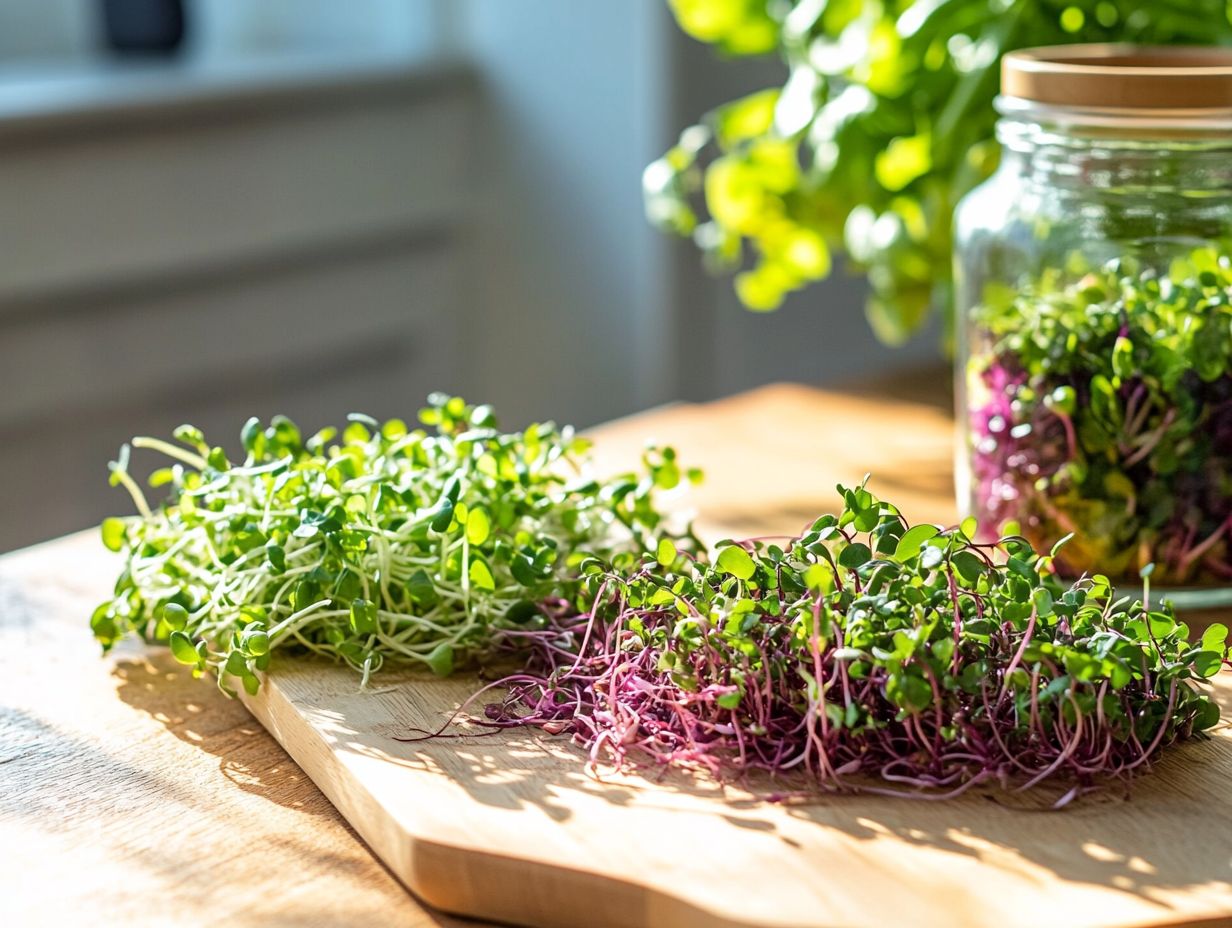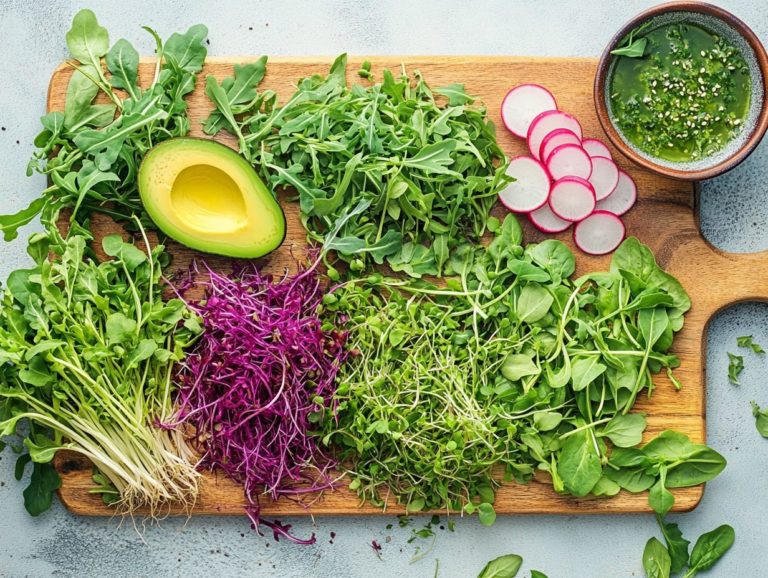Unlocking the Antioxidant Power of Microgreens
Get ready to discover the vibrant world of microgreens, tiny plants that boost flavor and health! Microgreens are tiny, nutrient-dense plants that pack a punch in both flavor and health benefits.
In this article, you’ll delve into what microgreens are and uncover why they are hailed as a superfood, brimming with antioxidants and essential vitamins. You will explore a variety of microgreens, each with its own unique advantages, and discover enticing ways to incorporate them into your meals.
You ll receive valuable tips on growing and storing your own microgreens, which are rich in nutrients.
Prepare to elevate your diet with the remarkable power of microgreens!
Contents
- Key Takeaways:
- What are Microgreens?
- Antioxidants in Microgreens
- How to Incorporate Microgreens into Your Diet
- Growing Your Own Microgreens
- Buying and Storing Microgreens
- Frequently Asked Questions
- What are microgreens and why are they beneficial?
- How do microgreens help unlock antioxidant power?
- What specific antioxidants can be found in microgreens?
- How can I incorporate microgreens into my diet for a healthy lifestyle?
- Are there any precautions to take when consuming microgreens?
- Do I need to eat a specific type of microgreen for its antioxidant benefits?
Key Takeaways:

- Boost your health today with nutrient-dense microgreens! Discover how easy it is to grow and use them in your meals.
- These superfoods can easily be grown at home, making them an eco-friendly choice, and offer a variety of health benefits, including improved immune function and reduced risk of chronic diseases.
- Whether added to salads, smoothies, or as a garnish, microgreens are a versatile and flavorful addition to any meal.
What are Microgreens?
Microgreens are young, edible plants that you harvest right after the first true leaves emerge. They are a great source of nutrition.
Their vibrant greens are not only visually appealing but also boast a high concentration of vitamins and minerals. These tiny greens, like radish microgreens, deliver an impressive flavor punch. It’s no wonder they ve captured the attention of health enthusiasts and culinary professionals alike.
Incorporating them into your meals offers a sustainable eating option while supporting urban gardening practices.
Definition and Nutritional Value
Microgreens are the young seedlings of edible vegetables and herbs, harvested at an early stage. They pack an impressive nutritional punch.
You ll find that these tiny powerhouses, including kale, radish, and basil, are loaded with exceptional levels of vitamins A, C, E, and K, each playing a vital role in boosting your overall health.
With their elevated antioxidant content, microgreens can significantly help combat oxidative stress, an imbalance between free radicals and antioxidants in the body, which is often linked to chronic diseases like heart disease and diabetes.
Their dietary fiber content not only aids digestion but also promotes gut health, ensuring that these nutrient-dense delights offer vibrant flavors alongside substantial health benefits.
Incorporating microgreens into your meals is an easy way to elevate your nutritional intake while also enhancing the visual appeal of your dishes. You ll be amazed at how these little gems brighten your meals and health!
Antioxidants in Microgreens
Microgreens are celebrated for their abundant antioxidant content, which plays a crucial role in combating free radicals and reducing oxidative stress.
By incorporating these nutrient-dense greens into your diet, you can unlock a myriad of health benefits, including potential cancer-fighting properties and enhanced cardiovascular health.
Types and Benefits

You ll find an impressive array of microgreen varieties at your fingertips, such as radish, broccoli, and red cabbage each bringing its own set of unique benefits along with a rich profile of antioxidants that elevate both flavor and nutritional value.
These delicate greens not only add a splash of vibrant color to your dishes but are also brimming with essential vitamins and minerals that are vital for your well-being.
Take broccoli microgreens, for example; they re particularly celebrated for their high concentration of glucosinolates, compounds that may contribute significantly to cancer prevention.
Meanwhile, the peppery zing of radish microgreens can transform even the simplest salad, and red cabbage brings a satisfying crunch along with a wealth of nutrients.
Health-conscious households like yours often seek out these nutrient-dense greens for their versatility in culinary applications, making it effortless to infuse powerful health benefits into everyday meals.
How to Incorporate Microgreens into Your Diet
Incorporating microgreens into your diet is a delightful and effortless way to elevate your meals. These vibrant, flavorful greens can seamlessly enhance salads, sandwiches, and smoothies. They significantly boost your nutrient intake with each bite.
Recipes and Serving Suggestions
Microgreens can be your culinary secret weapon. They transform various recipes from salads and soups to stunning garnishes that enhance the presentation of fresh vegetables. All this while delivering a powerhouse of flavor and nutrition.
These miniature marvels not only enhance the visual appeal of your dishes but also pack a punch with essential vitamins and a distinct taste. For a delightful starter, craft a vibrant microgreen pesto to toss with whole-grain pasta. You can also drizzle it artfully over grilled chicken.
In main courses, a microgreens salad can beautifully complement roasted vegetables and proteins. It adds that refreshing crunch and a peppery bite you didn t know you needed. Even your beverages can get a makeover; blend them into smoothies or use them as a cocktail garnish for a refreshing twist.
Innovate with creative serving ideas like layering microgreens on bruschetta or incorporating them into tacos. Their versatility makes it effortless to achieve nutrient-rich meals that impress.
Growing Your Own Microgreens
Growing your own microgreens is not just a rewarding endeavor; it’s an eco-friendly choice. It brings the joy of fresh, flavorful greens right to your home.
This makes it an ideal option for city gardeners and gardening enthusiasts seeking to elevate their culinary experience effortlessly.
Tips and Techniques

You must learn the best tips and techniques that foster healthy growth and nutrient cycles. This ensures you maximize your greens’ potential.
Focus on crucial elements like consistent watering practices, optimal temperature control, and finding the perfect balance of light exposure. For instance, some varieties thrive under bright light, while others prefer the gentleness of indirect sunlight. Adjusting your setup to meet these specific needs is vital.
Monitor humidity levels to prevent pesky issues like mold and pests that could jeopardize your crop. Opt for a well-draining soil mix to enhance root development. This allows your microgreens to flourish and yield their best.
By integrating these practical techniques, you can effectively troubleshoot problems and cultivate a thriving microgreen garden.
Buying and Storing Microgreens
When purchasing and storing microgreens, be discerning about selecting the freshest varieties. Proper storage techniques are essential to preserve their nutritional benefits and maximize their shelf life.
How to Choose and Keep Fresh
Choosing and keeping microgreens fresh starts with selecting the right varieties. Look for those that not only catch your eye but also deliver impressive health benefits and are rich in nutrients.
Seek vibrant greens that showcase vivid colors think deep greens, purples, or reds. These hues often indicate high levels of antioxidants. The texture of the leaves is crucial; they should be tender yet crisp, a clear sign of their freshness.
When picking your microgreens, take a moment to appreciate their aroma; a fresh scent usually signifies optimal flavor and vitality. To preserve these delightful qualities, gently rinse them under cool running water to remove any dirt.
Then dry them off using a salad spinner or paper towels. Store your microgreens in a breathable container lined with a damp paper towel. This helps maintain their crispness and extends their shelf life. Don t miss out on the chance to enjoy their incredible flavors and health benefits for longer!
Explore more about cooking with microgreens to unlock their full potential in your meals.
Frequently Asked Questions
What are microgreens and why are they beneficial?

Microgreens are young vegetable greens. They are harvested after sprouting but before they grow fully.
These greens pack a nutrient punch, offering more benefits than their mature counterparts. Adding them to your diet can greatly enhance your health!
How do microgreens help unlock antioxidant power?
Microgreens are rich in antioxidants. These compounds protect your cells from damage caused by harmful molecules called free radicals.
Free radicals can lead to aging and diseases, including cancer and heart disease. Eating microgreens helps neutralize these threats!
What specific antioxidants can be found in microgreens?
You’ll find a variety of antioxidants in microgreens, such as vitamins C, E, and K, as well as beta-carotene, lutein, and zeaxanthin. These nutrients can reduce inflammation, boost your immune system, and support eye health.
How can I incorporate microgreens into my diet for a healthy lifestyle?
Microgreens are versatile! You can add them to salads, sandwiches, smoothies, and stir-fries.
They have a mild flavor and easily enhance your meals. You can even grow them at home for a fresh and cost-effective option!
Are there any precautions to take when consuming microgreens?
Microgreens are generally safe to eat. However, wash them thoroughly to remove any potential bacteria or dirt.
Always buy from reputable sources to guarantee freshness and safety.
Do I need to eat a specific type of microgreen for its antioxidant benefits?
There are many types of microgreens, each offering unique nutrients. Eating a variety ensures you gain the most antioxidant benefits!
Popular choices include broccoli, kale, radish, and sunflower microgreens.






